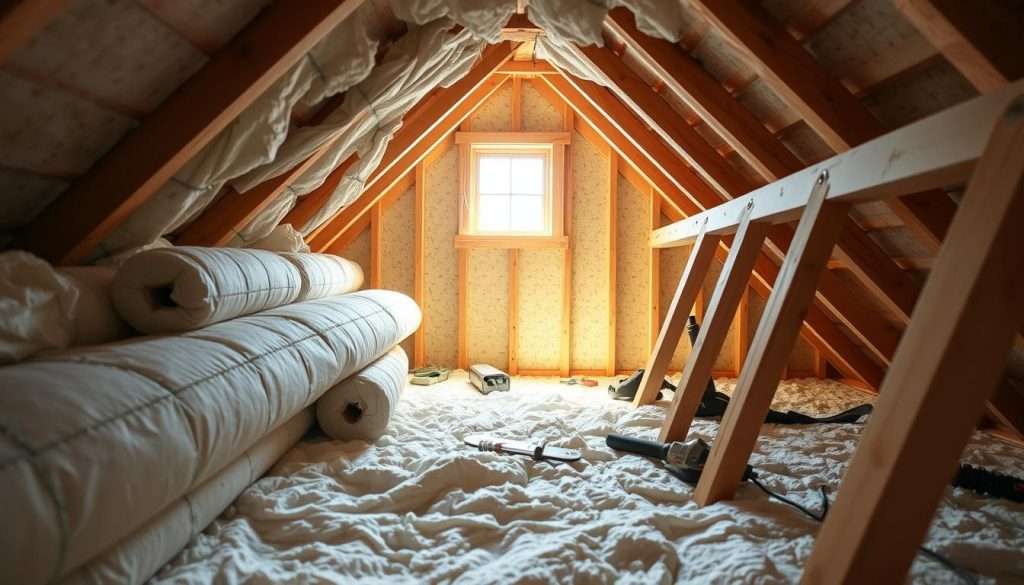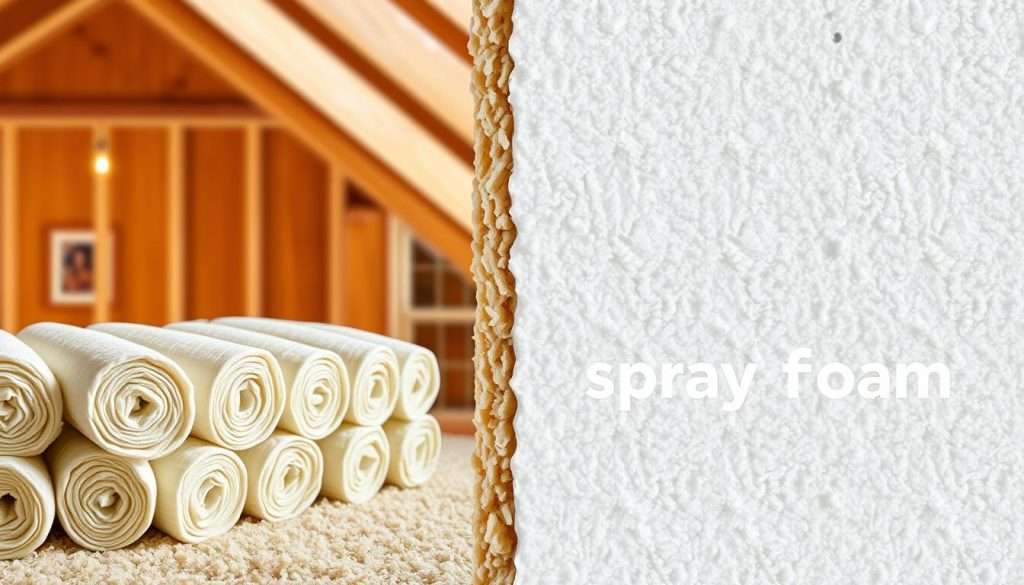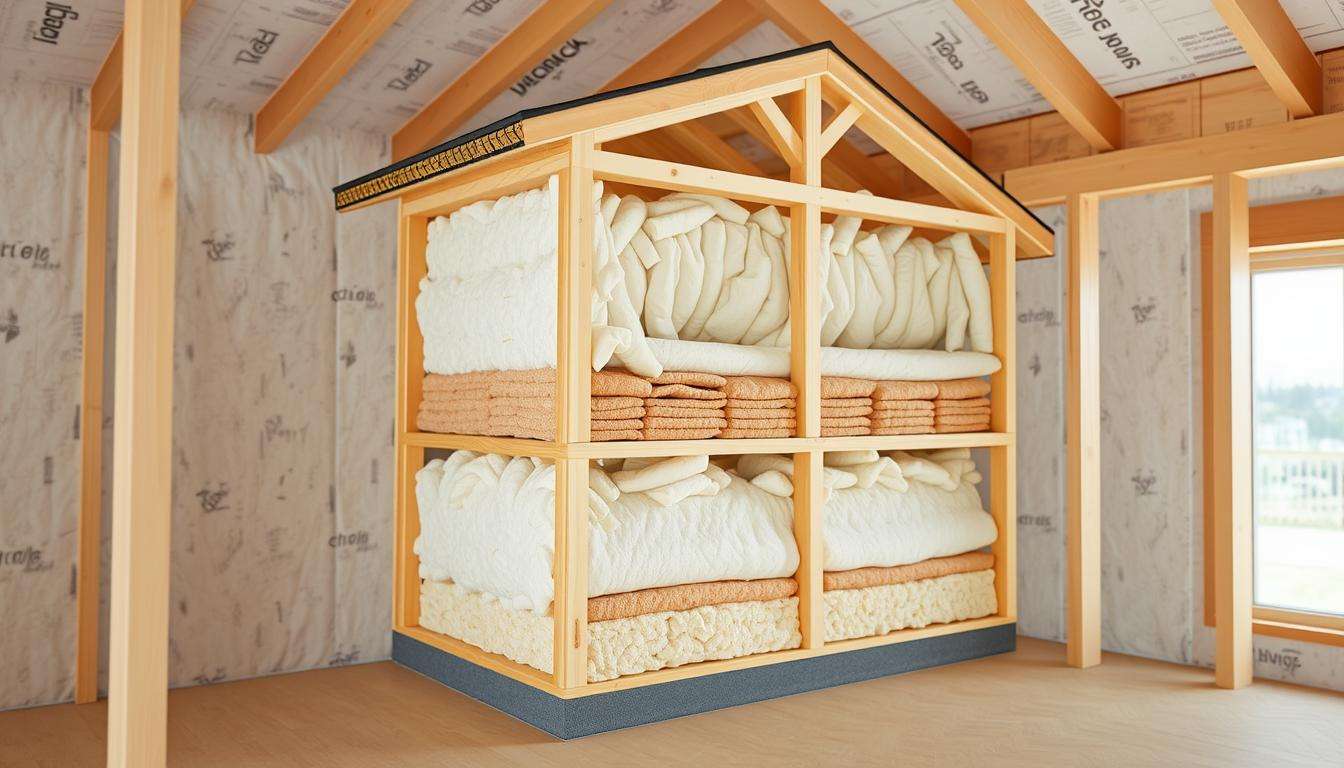Batt insulation makes your home more energy efficient and cozy. It’s made from materials like fiberglass, mineral wool, or cotton. These pieces fit into walls, ceilings, and floors, saving you money on energy.
Many people choose batt insulation because it’s affordable. Fiberglass batts are the cheapest option. They work well in many places, like floors, walls, and ceilings. They also keep your home quiet and warm.
This guide will cover batt insulation types, benefits, and how to install it. We’ll help you make the right choice for your home.
Key Takeaways
- Fiberglass is the most common material used for batt insulation.
- Batt insulation is one of the least expensive ways to insulate a home.
- Proper installation is crucial to maximize the effectiveness of batt insulation.
- Different types include fiberglass, mineral wool, and cotton, catering to various needs.
- Regular maintenance checks can help sustain insulation performance.
- The R-value determines the insulation’s ability to resist heat flow, vital for efficiency.
Introduction to Batt Insulation
Batt insulation is a common way to keep homes warm or cool. It stops heat from moving, making rooms comfy. This helps save money on heating and cooling.
Definition and Purpose
Batt insulation is made of pre-cut pieces or rolls. It fits between wall studs. The benefits of batt insulation include keeping warm in winter and cool in summer. It also makes rooms quieter.
When installed right, batt insulation can cut energy bills by half. This makes homes more efficient and cozy.
Importance in Construction
In building homes, batt insulation is key. It keeps energy in and makes buildings comfy. It doesn’t lose shape over time.
Choosing the right thickness is important. For 2×4 walls, use R-13 or R-15. For 2×6 walls, go with R-19 or R-21. Batt insulation is cheap, making it easy for many to afford.
Types of Batt Insulation
Knowing about batt insulation types helps you choose the right one for your home. Each type has its own benefits and uses. Let’s look at the main types: fiberglass, mineral wool, and cotton.
Fiberglass Batt Insulation
Fiberglass batt insulation is very common. It’s made from glass fibers and is both light and affordable. It has an R-value of 2.9 to 4.3 per inch, helping control heat.
It works well in many places, like floors, walls, and attics.
Mineral Wool Batt Insulation
Mineral wool batt insulation is made from rock or slag fibers. It’s known for its good heat resistance and soundproofing. It also doesn’t get wet easily, making it perfect for damp places.
With an R-value of 4-5 per inch, it’s more energy-efficient than some others.
Cotton Batt Insulation
Cotton batt insulation is a natural and green choice. It’s made from recycled cotton, like old jeans. It has R-values of 3 to 4 per inch and is better for the planet.
| Type of Batt Insulation | Material | R-Value (per inch) | Benefits |
|---|---|---|---|
| Fiberglass Batt Insulation | Glass fibers | 2.9 – 4.3 | Lightweight, cost-effective, versatile |
| Mineral Wool Batt Insulation | Rock or slag fibers | 4 – 5 | Excellent thermal resistance, soundproofing, moisture-resistant |
| Cotton Batt Insulation | Recycled cotton | 3 – 4 | Eco-friendly, sustainable, lower environmental impact |
R-Value and Thermal Performance
Knowing about R-value is key to good insulation in your home. R-value shows how well insulation stops heat flow. The higher the R-value, the better your home will keep energy in.
Different insulation materials have different R-values. For batt insulation, values range from 2.1 to 3.6 per inch. In cold places, you need at least R-49, or 16 inches of fiberglass. Warmer areas might need R-38 or more, which is about 12 inches of insulation.
It’s important to match your R-value with your climate zone. The U.S. Department of Energy has guidelines for each zone. This helps your home stay energy-efficient.
- Cold Climates: Aim for an R-25 rating for floor insulation.
- Basement Walls: Suggested R-values range from R-10 to R-15.
- Unventilated Crawl Spaces: Require R-values between R-16 to R-20.
How R-Value Affects Energy Efficiency
Insulation’s R-value greatly affects energy use. Proper insulation in walls, attics, and crawl spaces saves money and keeps you cozy. Adding more insulation, like foam board, boosts thermal performance and cuts down on heat loss.
Choosing the right batt insulation is crucial. Fiberglass batts for 2-inch x 4-inch walls are R-11 to R-15. Spray foam can reach R-14 to R-28, perfect for tight spaces.
Keeping insulation in top shape is vital. Fixing issues like compression and moisture helps it work better. By improving your batt insulation’s R-value, you make your home more comfortable and save money.
| Insulation Type | R-Value per Inch | Recommended R-Value for Attics | Recommended R-Value for Walls |
|---|---|---|---|
| Fiberglass Batt | R-2.1 to R-3.6 | R-49 in Cold Climates | R-11 to R-15 |
| Spray Foam | R-5.6 to R-8.0 | R-38 or More in Warmer Regions | R-14 to R-28 |
| Polyisocyanurate Foam | R-5.6 to R-8.0 | Based on Climate Zone | Variable |
Installation Process for Batt Insulation
Installing batt insulation needs the right tools and a clear plan. We’ll show you what tools you need, how to install step by step, and safety tips. This will help make the process smooth.
Tools and Materials Needed
First, get these tools and materials ready:
- Utility knife
- Tape measure
- Staple gun
- Safety goggles
- Gloves
Step-by-Step Installation Guide
Here’s how to install batt insulation:
- Measure the space between studs and cut batts a bit larger for a good fit.
- Put each batt tightly in the wall cavities, making sure there are no gaps.
- For corners or obstacles, cut batts carefully to fit without losing coverage.
- Install vapor barriers as needed to stop moisture problems.
- Make sure to seal air well with caulking or special systems to improve performance.

Safety Precautions
When working with batt insulation, remember these safety tips:
- Wear safety goggles and gloves to protect your skin and eyes from irritants.
- Use a mask to avoid breathing in dust, especially from fiberglass.
- Keep the work area well-ventilated to avoid breathing in too much dust.
Being ready with the right tools and following these steps will help you install batt insulation safely and successfully.
Benefits of Using Batt Insulation
Batt insulation is great for homes. It makes living more comfortable, saves money, and is good for the planet. Let’s see how it helps with energy, noise, and being green.
Energy Efficiency
Batt insulation keeps your home warm or cool. This means you use less energy and save money. The R-Value shows how well it works. Thicker batts are better for very cold or hot places.
Noise Reduction
Batt insulation also blocks out noise. This makes your home quieter. It helps keep out outside sounds and noise between rooms.
Environmentally Friendly Options
There are green batt insulation choices. For example, cotton insulation is made from 85% recycled cotton. These options might cost a bit more. But they’re good for the planet and save energy.
| Benefit | Description |
|---|---|
| Energy Efficiency | Maintains indoor temperatures, lowering energy bills. |
| Noise Reduction | Acts as a sound barrier, enhancing home acoustics. |
| Environmentally Friendly Options | Includes materials like cotton and sheep’s wool, promoting recycling and sustainability. |
Considerations Before Choosing Batt Insulation
When picking batt insulation for your home, many things matter. These things affect how well it works. Knowing what to look for is key to picking the right one for you.
Climate and Location
Your area’s weather is very important. It decides how thick and what kind of insulation you need. For example, the U.S. Department of Energy says:
- 13-14 inches (R-38) of insulation for homes in southern climates.
- 16-18 inches (R-49) for northern climates.
In colder places, you need more insulation to keep warm. In warmer places, you need less. Choosing the right insulation for your area is important to save energy. There are many types of batt insulation for different places.
Space Availability and Design
Before you start, check how much room you have. Also, think about how your home’s design affects insulation. Key things to remember are:
- Make sure there’s enough room for the insulation you choose.
- Features like gaps can affect what insulation you can use, so pick carefully.
Each type of batt insulation is different. They fit and work in various ways. Checking your space well helps you get the best results.
| Climate Zone | Recommended R-Value | Common Insulation Types |
|---|---|---|
| Southern | R-38 | Fiberglass, Cellulose |
| Northern | R-49 | Mineral Wool, Fiberglass |
By looking at your area’s weather and your home’s layout, you can choose wisely. This choice will make your home more energy-efficient and cozy.
Common Mistakes in Batt Insulation Installation
Putting batt insulation in right is key for saving energy and keeping your home comfy. Many people make mistakes that make insulation not work well. Knowing these mistakes can help you save money and energy.
Gaps and Compression Issues
Not fitting batts well into the frame is a big problem. Gaps, especially in tight spots, let cold air through. This makes insulation less effective.
Also, squishing insulation too much can make it lose its power. When insulation gets flat, it doesn’t work as well. This means you’ll spend more on energy.
Inadequate Coverage
Not covering all areas is another big issue. Missing spots like corners and edges lets energy escape. This makes your insulation not work as well.
To fix this, make sure to cover every area. Using vent baffles helps keep air flowing. This stops mold and keeps humidity levels right.
Comparing Batt Insulation to Other Types
When picking insulation, knowing the differences is key. Batt insulation and others have their own pluses and minuses. These affect how well they work and how they’re installed.
Batt vs. Spray Foam
Batt and spray foam insulation are quite different. Spray foam seals air tight and keeps heat in better. It can reach R-6.5 per inch, making it top for saving energy.
Fiberglass batts, on the other hand, have an R-value of R-2.9 to R-3.8 per inch. They’re good for many places but can’t seal air like spray foam. Spray foam needs pros to apply and costs more. But, batts are easier to put in yourself.
Batt vs. Rigid Foam Board
Batt and rigid foam board have their own strengths. Rigid foam boards have an R-value of R-3.8 to R-8.0 per inch. This is better than most batts.
But, putting in rigid foam boards is harder than batts. Batt insulation fits well in walls and can fill gaps. Rigid foam boards are good but can’t fit as snugly. Think about how easy it is to install and waste when choosing.

| Insulation Type | R-Value Per Inch | Installation Complexity | Air-Sealing Capability |
|---|---|---|---|
| Fiberglass Batt | R-2.9 to R-4.3 | Easy | Moderate |
| Closed-Cell Spray Foam | R-5.5 to R-6.5 | Complex | Excellent |
| Rigid Foam Board | R-3.8 to R-8.0 | Moderate | Good |
Cost Factors for Batt Insulation
Knowing how much batt insulation costs is key for homeowners. Prices change based on materials, labor, and where you live. We’ll look at the average cost per square foot and how it can save you money on energy bills.
Price Per Square Foot
The cost for batt insulation per square foot is between $0.80 and $2.60. The materials alone can be $0.10 to $2.00 per square foot. The cost to install depends on the insulation’s R-value and how complex the job is. Here’s a cost breakdown:
| Area | Cost Range | Typical Project Size |
|---|---|---|
| Attic Floor | $1,100 – $3,900 | 1,000 sq ft |
| Exterior Walls (Whole House) | $1,100 – $5,300 | 1,500 sq ft |
| Ceilings (Whole House) | $2,000 – $11,800 | 1,500 sq ft |
| Garage Walls | $670 – $2,600 | 500 sq ft |
Long-Term Savings on Energy Bills
Choosing high-quality batt insulation can cut your energy costs over time. It makes your home more energy-efficient. This leads to:
- Lower energy bills because of better insulation.
- More comfort because your home stays at a steady temperature.
- Less harm to the environment by using less fossil fuels.
With the right batt insulation, the upfront cost is worth it. It saves you money in the long run, making it a wise choice for homeowners.
Maintenance and Inspection of Batt Insulation
Regular batt insulation maintenance is key to keeping your insulation working well. Without regular checks, big problems can happen. These can make your energy bills go up and harm your home’s air.
Regular Checks for Damage
It’s important to check your batt insulation often. Look closely at:
- Moisture damage, which can make insulation less effective
- Pest invasions that can harm your home’s structure and insulation
- Physical wear and tear, especially in busy or easy-to-reach spots
Fixing these problems quickly helps your insulation last longer.
Signs of Insulation Degradation
Watch out for signs of insulation damage. These signs mean you might need to fix or replace it. Look for:
- Sagging insulation
- Musty smells that mean mold might be growing
- Visible mold or mildew on or near the insulation
Spotting these signs early stops bigger problems. Check your insulation at least once a year to catch issues fast.
FAQs About Batt Insulation
Thinking about batt insulation for your home? You might wonder how long it lasts and if you can reuse it. Knowing these things helps you choose the best insulation for your needs.
How Long Does Batt Insulation Last?
Batt insulation usually lasts 20 to 30 years. Its lifespan depends on several factors. Moisture and pests can affect how long it lasts.
Proper installation and care can make it last longer.
Can Batt Insulation Be Reused?
Wondering if you can reuse batt insulation? Yes, you can. It needs a good clean and check first. This keeps it working well.
Conclusion: Choosing the Right Insulation
In our batt insulation guide, we’ve looked at many aspects of insulation. This helps you choose the best for your home. When picking batt insulation, think about your needs and your area’s weather.
Insulation keeps your home’s temperature steady. This can save you a lot on heating and cooling costs. Batt insulation fits well and keeps the cold out and the warm in.
Final Thoughts and Recommendations
When you start your insulation project, think about what’s important to you. Look at the material, its R-value, and your budget. Choosing good batt insulation saves energy and makes your home cozy.
Make smart choices, and you’ll enjoy the benefits of good insulation for a long time.
